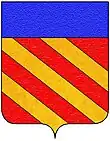House of Caracciolo
The House of Caracciolo (Italian pronunciation: [kaˈrattʃolo]) is a prominent aristocratic family from the city of Naples. The Caracciolos are considered one of the most important families in the history of the Kingdom of Naples, and also held relevant posts in the Spanish Empire.
History
According to a tradition based on the writings of Agatharchides of Cnidos and Sergius the Confessor, the family is of Greek descent, originating from the Byzantine nobility.[1] The first documented mention of the family date back to the 10th century with the progenitor Teodoro Caracciolo, who was reported in ancient documents as Theodorus Caracziolus, of which only archival information is available; he was buried together with his wife Urania in the Cathedral of the Assumption of Mary in Naples. He is reported to have died on 20 March 976, the date of a document in which it is learned that in this period his daughter Theodonanda made a donation to the Monastery of Saints Sergius and Bacchus in Naples.[2][3]
At the time of the Duchy of Naples, the family enjoyed nobility during the reign of the Sergian dynasty, benefiting from special privileges granted by Sergius VII of Naples. The family then divided into numerous lines, including the ancient lines of the likes of Caracciolo Canella, Caracciolo Ugot, Caracciolo Viola, and Caracciolo Ciccola, then into the lines of the likes of the del Sole, Bianchi, Rossi, and Pisquizi. Specifically, Riccardo Caracciolo, son of Landolfo, who lived in the early 12th century, was the progenitor of the Caracciolo Rossi. Caracciolo Pisquizi Filippo, also son of Landolfo, was the progenitor of the branch of the Caracciolo del Sole and that of the Caracciolo di Pisciotta.[4]
In 1869, the family was enrolled in the Libro d'Oro, the Golden Book of the Italian nobility. Thanks to the great importance of the Caracciolo family, most of the most important events of the Kingdom of Naples had various members of the family as protagonists, sometimes even on opposing fronts.[5]
Notable members
- Niccolo d'Ardia Caracciolo (1941–1989), painter from a branch in Ireland since the 20th century
- Nicola Caracciolo (1931–2020), 10th Prince of Castagneto, 5th Duke di Melito, journalist, and historian
- Marella Caracciolo (1927–2019), Princess of Castagneto, art collector, designer, and widow of Gianni Agnelli
- Carlo Caracciolo (1925–2008), 9th Prince of Castagneto, 4th Duke of Melito, newspaper publisher, and founder of Gruppo Editoriale L'Espresso
- Franco Caracciolo (1920–1999), actor and conductor
- Filippo Caracciolo (1903–1965), 8th Prince of Castagneto, 3rd Duke di Melito
- Rudolf Caracciola (1901–1959), racing driver from a branch in Germany since the 17th century
- Giuseppe Caracciolo (1892–1975), cinematographer
- Miriam Caracciolo di Melito (1888–1966), American socialite and wife of Mario Caracciolo di Melito
- Mario Caracciolo di Melito (1883–1958), Italian cavalry officer and American actor known as Mario Carillo
- Filippo Giudice Caracciolo (1785–1844), Archbishop of Naples (1833–1844)
- Tommaso Caracciolo (1687–1689), Bishop of Gerace
- Carmine Nicolao Caracciolo (1671–1726), Viceroy of the Spanish Colony of Peru from a branch in Spain since the 16th century
- Tommaso Caracciolo (1636–1637), Archbishop of Taranto
- Gerolamo Caracciolo (1617–1682), Marqués de Torrecuso, Governor of Navarre, and soldier from a branch in Spain since the 16th century
- Tommaso Caracciolo, Count of Roccarainola (1572–1631), Spanish field marshal
- Pasquale Caracciolo (1566–1608), writer and horsemanship expert
- Tommaso Caracciolo (1478–1546), Archbishop of Capua (1536–1546), Bishop of Trivento (1502–1540), and Bishop of Capaccio (1523–1531)
- Marino Caracciolo (1468–1538), cardinal and diplomat
- Giovanni Caracciolo (c. 1372–1432), minister of the Kingdom of Naples and favourite of Queen Joanna II who was often called Sergianni
- Riccardo Caracciolo (c. 1320–1395), one of two rival Grand Masters of the Knights Hospitaller
References
- Hasiotis, Ioannis K. (1966). Makarios, Theodoros kai Nikiforos oi Melissinoi (Melissourgoi) (16os-17os ai) Μακαριος, Θεοδωρος και Νικηφορος οι Μελισσηνοι (Μελισσουργοι) (16ος-17ος αι) [Makarios, Theodoros and Nikiforos the Melissinoi (Beekeepers) (16th–17th century)] (in Greek). Thessaloniki: Society for Macedonian Studies. p. 176.
-O Papadópoulos theoreí tin oikogéneia aftí ellinikís katagogís. Kai eínai alítheia óti kai símera akómi ypárchei i parádosi óti oi Caracciolo échoun vyzantiní katagogís í parádosi aftí stiríchtike se apospásmata tou Agatharchídi apó tin Knído kai tou Sergíou tou Omologitou ... .
[– Papadopoulos considers this family to be of Greek origin. And it is true that even today there is still a tradition that the Caracciolos are of Byzantine origin, or this tradition was based on passages from Agatharchides from Knidos and Sergius the Confessor ... .] - "Caracciolo". Italian Encyclopedia (in Italian). 1930. Retrieved 17 February 2023 – via Treccani.
- "Storia dei Caracciolo" [History of the Caracciolos]. Sito Roccaromana (in Italian). 2010. Retrieved 17 February 2023.
- "Famiglia Caracciolo-Rossi" [Caracciolo-Rossi family]. Nobili napoletani (in Italian). 2007. Retrieved 17 February 2023.
- Pescatore, Gerardo (April 2017). "La storia dei Caracciolo, principi di Avellino" [The history of the Caracciolos, princes of Avellino] (PDF). Avellinesi.it (in Italian). Retrieved 17 February 2023.
Bibliography
- Cancelliere, Maria Pina (2012). Lo Stato feudale dei Caracciolo di Torella: poteri, istituzioni e rapporti economico-sociali nel Mezzogiorno moderno. Avellino: Terebinto Editore. ISBN 978-88-97-48907-8.
External links
- Nobili napoletani (in Italian)
